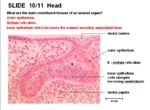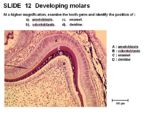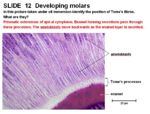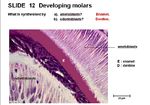Difference between revisions of "Tooth - Anatomy & Physiology"
| (20 intermediate revisions by 4 users not shown) | |||
| Line 1: | Line 1: | ||
| + | {{OpenPagesTop}} | ||
==Anatomy of the Enamel Organ== | ==Anatomy of the Enamel Organ== | ||
[[Image:Soft Histology of Enamel Organ.jpg|thumb|right|150px|Histology of Enamel Organ - Copyright RVC 2008]] | [[Image:Soft Histology of Enamel Organ.jpg|thumb|right|150px|Histology of Enamel Organ - Copyright RVC 2008]] | ||
| Line 6: | Line 7: | ||
*'''Outer epithelium''' | *'''Outer epithelium''' | ||
*'''Stellate reticulum'''- star shaped cells lying between the outer and inner epithelial layers. It has the appearance of connective tissue but is of epithelial derivation. | *'''Stellate reticulum'''- star shaped cells lying between the outer and inner epithelial layers. It has the appearance of connective tissue but is of epithelial derivation. | ||
| − | *'''Inner epithelium''' which becomes the enamel secreting [[Ameloblasts|ameloblast]] layer | + | *'''Inner epithelium''' which becomes the enamel secreting [[Tooth - Anatomy & Physiology#Ameloblasts|ameloblast]] layer |
| + | ==Tooth Components== | ||
The enamel organ has many different components. These consist of: | The enamel organ has many different components. These consist of: | ||
===Crown=== | ===Crown=== | ||
| Line 15: | Line 17: | ||
===Root=== | ===Root=== | ||
| − | Teeth may have one or more roots. The furcation angle is the point where roots diverge. The root ends in an apex which is where the nerves, blood vessels and lymphatics travel to the [[ | + | Teeth may have one or more roots. The furcation angle is the point where roots diverge. The root ends in an apex which is where the nerves, blood vessels and lymphatics travel to the [[Tooth - Anatomy & Physiology#Pulp|pulp]]. '''Hypsodont''' teeth can have open roots (aradicular) e.g. in rabbits which have continued growth. Hypsodont teeth can have closed roots (radicular) e.g. horse where growth decreases with age. '''Brachydont''' teeth have no capacity for growth and so the roots are closed. |
'''Species Differences''' | '''Species Differences''' | ||
| − | The apex has a single foramen in dogs and cats. It remains open in herbivores. In the horse, the apex closes as the animal ages. Brachiocephalic dogs often have fused roots. Equine incisors have fused roots. In the horse's canines, the size of the root is much larger than the [[ | + | The apex has a single foramen in dogs and cats. It remains open in herbivores. In the horse, the apex closes as the animal ages. Brachiocephalic dogs often have fused roots. Equine incisors have fused roots. In the horse's canines, the size of the root is much larger than the [[Tooth - Anatomy & Physiology#Crown|crown]]. |
===Alveolar Bone=== | ===Alveolar Bone=== | ||
The alveolar processes of the jaw consists of the '''alveolar bone''', '''trabecular bone''' and '''compact bone'''. | The alveolar processes of the jaw consists of the '''alveolar bone''', '''trabecular bone''' and '''compact bone'''. | ||
| − | The densest bone called the '''cribiform plate''' lines the alveolus. This appears white on radiographs and is referred to as the '''[[ | + | The densest bone called the '''cribiform plate''' lines the alveolus. This appears white on radiographs and is referred to as the '''[[Tooth - Anatomy & Physiology#Lamina Dura|lamina dura]]'''. |
===Lamina Dura=== | ===Lamina Dura=== | ||
| − | The '''lamina dura''' lines the [[ | + | The '''lamina dura''' lines the [[Tooth - Anatomy & Physiology#Alveolar Bone|alveolar bone]]. If uninterrupted, it indicates good dental health. |
The '''lamina dura''' is seen as a white line radiographically. | The '''lamina dura''' is seen as a white line radiographically. | ||
===Enamel=== | ===Enamel=== | ||
| − | Enamel has an '''ectodermal''' origin. It is synthesised by [[Ameloblasts|ameloblasts]]. It is very hard, densly calcified and '''acellular''', therefore cannot regenerate. | + | Enamel has an '''ectodermal''' origin. It is synthesised by [[Tooth - Anatomy & Physiology#Ameloblasts|ameloblasts]]. It is very hard, densly calcified and '''acellular''', therefore cannot regenerate. |
| − | Complicated enamel folding occurs in teeth where the '''[[ | + | Complicated enamel folding occurs in teeth where the '''[[Tooth - Anatomy & Physiology#Crown|crowns]]''' are high. Enamel forming secretions pass through processes of apical cytoplasmic extension called '''Thomes' Fibres'''. |
===Dentine=== | ===Dentine=== | ||
| − | '''Dentine''' is a calcified, collagen rich matrix. It is synthesised by '''[[ | + | '''Dentine''' is a calcified, collagen rich matrix. It is synthesised by '''[[Tooth - Anatomy & Physiology#Odontoblasts|odontoblasts]]'''. |
'''Secondary dentine''' is produced throughout life and increases with rate of repair. It is darker in colour than '''primary dentine'''. | '''Secondary dentine''' is produced throughout life and increases with rate of repair. It is darker in colour than '''primary dentine'''. | ||
===Cementum=== | ===Cementum=== | ||
| − | '''Cementum''' is synthesised by '''[[ | + | '''Cementum''' is synthesised by '''[[Tooth - Anatomy & Physiology#Cementoblasts|cementoblasts]]'''. It is calcified tissue and lacks regular organisation. Collagen fibres extend from the cementum into the '''[[Tooth - Anatomy & Physiology#Periodontal Ligament|periodontal ligament]]''' to fasten the tooth in its socket. '''Cementum''' is relatively immune to pressure erosion, therefore the tooth can be remodelled in its socket. |
===Pulp=== | ===Pulp=== | ||
| − | Pulp fills the dental cavity. It is a delicate connective tissue bordering the [[ | + | Pulp fills the dental cavity. It is a delicate connective tissue bordering the [[Tooth - Anatomy & Physiology#Odontoblasts|odontoblast]] layer. It is highly vascularised and contains a lymphatic plexus. |
Pulp allows pain sensation to thermal, mechanical and chemical stimulants. Most of the nervous supply is sensory, with some vasomotor input. | Pulp allows pain sensation to thermal, mechanical and chemical stimulants. Most of the nervous supply is sensory, with some vasomotor input. | ||
===Periodontal Ligament=== | ===Periodontal Ligament=== | ||
| − | The collagen fibre bundles are called '''Sharpey's fibres'''. The fibres insert into the [[ | + | The collagen fibre bundles are called '''Sharpey's fibres'''. The fibres insert into the [[Tooth - Anatomy & Physiology#Alveolar Bone|alveolar bone]] and [[Tooth - Anatomy & Physiology#Cementum|cementum]] of the tooth. |
There are 3 categories: gingival, trans-septal and alveolodental. There are evenly distributed blood vessels and nerve fibres transmitting thermal, pain and pressure sensation. Some species can also sense proprioception in the periodontal ligament. | There are 3 categories: gingival, trans-septal and alveolodental. There are evenly distributed blood vessels and nerve fibres transmitting thermal, pain and pressure sensation. Some species can also sense proprioception in the periodontal ligament. | ||
| Line 58: | Line 60: | ||
[[Image:Ameloblast Histology.jpg|thumb|right|150px|Ameloblast Histology - Copywright RVC 2008]] | [[Image:Ameloblast Histology.jpg|thumb|right|150px|Ameloblast Histology - Copywright RVC 2008]] | ||
===Ameloblasts=== | ===Ameloblasts=== | ||
| − | '''Ameloblasts''' are cells in the enamel organ which forms the tooth. They secrete '''[[ | + | '''Ameloblasts''' are cells in the enamel organ which forms the tooth. They secrete '''[[Tooth - Anatomy & Physiology#Enamel|enamel]]'''. |
| − | Epithelial cells line the inner surface of the enamel organ. '''Ameloblasts''' are derived from epithelium and form a single layer of very long columnar cells that are hexagonal in cross section. They have elongated, basally sited nuclei. They synthesise '''[[ | + | Epithelial cells line the inner surface of the enamel organ. '''Ameloblasts''' are derived from epithelium and form a single layer of very long columnar cells that are hexagonal in cross section. They have elongated, basally sited nuclei. They synthesise '''[[Tooth - Anatomy & Physiology#Enamel|enamel]]''' which forms the '''[[Tooth - Anatomy & Physiology#Crown|crown]]''' of each tooth. They maintain connections with the newly synthesised '''[[Tooth - Anatomy & Physiology#Enamel|enamel]]''' through cellular projections called '''Thomes' fibres'''. |
| − | '''[[ | + | '''[[Tooth - Anatomy & Physiology#Enamel|Enamel]]''' is acellular so once the connection with the ameloblasts via the '''Thomes' fibres''' is lost (upon eruption), the [[Tooth - Anatomy & Physiology#Enamel|enamel]] matrix cannot be remodelled. |
| + | ===Odontoblasts=== | ||
| + | The '''odontoblasts''' are cells in the '''enamel organ''' which forms the tooth. They secrete '''[[Tooth - Anatomy & Physiology#Dentine|dentine]]'''. | ||
| − | + | '''Odontoblasts''' are derived from mesenchyme and are composed of a single layer of elongated columnar cells. They are at the '''dental-pulp border'''. They secrete '''[[Tooth - Anatomy & Physiology#Dentine|dentine]]''' which is a mineralised matrix of collagen I, [[Tooth - Anatomy & Physiology#Dentine|dentine]] and proteins. | |
| − | |||
| − | + | The first layer of [[Tooth - Anatomy & Physiology#Dentine|dentine]] is formed on the enamel organ. As production increases, the odontoblasts are displaced from the [[Tooth - Anatomy & Physiology#Enamel|enamel]]. It is a major part of the tooth structure and is produced continually by the odontoblasts. The rate of [[Tooth - Anatomy & Physiology#Dentine|dentine]] synthesis is increased during repair as it is innervated (but still acellular). | |
| − | [[ | + | ===Cementoblasts === |
| + | '''Cementoblasts''' are cells in the '''[[Tooth - Anatomy & Physiology#Enamel|enamel]]''' organ which forms the tooth. They secrete '''[[Tooth - Anatomy & Physiology#Cementum|cementum]]'''. | ||
| + | Epithelial cells are present near the distal end of the cup. They become follicle cells. '''Cementoblasts''' synthesise [[Tooth - Anatomy & Physiology#Cementum|cementum]] which mostly contains '''collagen I'''. | ||
| + | [[Tooth - Anatomy & Physiology#Cementum|Cementum]] surrounds the '''[[Tooth - Anatomy & Physiology#Dentine|dentine]]''' of the [[Tooth - Anatomy & Physiology#Root|root]]. [[Tooth - Anatomy & Physiology#Cementum|Cementum]] is acellular and not readily absorbed. | ||
| + | {{Template:Learning | ||
| + | |flashcards = [[Teeth and Gingiva Flashcards]] | ||
| + | |powerpoints = [[Oral Cavity Histology resource|Interactive tutorial on development of teeth]] | ||
| + | |dragster = [[Oral Cavity Histology Resource (I)]] | ||
| + | |Vetstream = [https://www.vetstream.com/canis/search?s=teeth Teeth] | ||
| + | }} | ||
| + | |||
| + | |||
| + | {{OpenPages}} | ||
[[Category:Teeth - Anatomy & Physiology]] | [[Category:Teeth - Anatomy & Physiology]] | ||
| − | |||
Revision as of 09:40, 7 May 2016
Anatomy of the Enamel Organ
The main components which form the enamel organ are:
- Outer epithelium
- Stellate reticulum- star shaped cells lying between the outer and inner epithelial layers. It has the appearance of connective tissue but is of epithelial derivation.
- Inner epithelium which becomes the enamel secreting ameloblast layer
Tooth Components
The enamel organ has many different components. These consist of:
Crown
The crown is covered by enamel. It meets the root at the cemento-enamel junction (CEJ).
The crown of incisors have only one cusp. The crown of molars have up to 4 cusps for the grinding of food.
Root
Teeth may have one or more roots. The furcation angle is the point where roots diverge. The root ends in an apex which is where the nerves, blood vessels and lymphatics travel to the pulp. Hypsodont teeth can have open roots (aradicular) e.g. in rabbits which have continued growth. Hypsodont teeth can have closed roots (radicular) e.g. horse where growth decreases with age. Brachydont teeth have no capacity for growth and so the roots are closed.
Species Differences
The apex has a single foramen in dogs and cats. It remains open in herbivores. In the horse, the apex closes as the animal ages. Brachiocephalic dogs often have fused roots. Equine incisors have fused roots. In the horse's canines, the size of the root is much larger than the crown.
Alveolar Bone
The alveolar processes of the jaw consists of the alveolar bone, trabecular bone and compact bone.
The densest bone called the cribiform plate lines the alveolus. This appears white on radiographs and is referred to as the lamina dura.
Lamina Dura
The lamina dura lines the alveolar bone. If uninterrupted, it indicates good dental health.
The lamina dura is seen as a white line radiographically.
Enamel
Enamel has an ectodermal origin. It is synthesised by ameloblasts. It is very hard, densly calcified and acellular, therefore cannot regenerate.
Complicated enamel folding occurs in teeth where the crowns are high. Enamel forming secretions pass through processes of apical cytoplasmic extension called Thomes' Fibres.
Dentine
Dentine is a calcified, collagen rich matrix. It is synthesised by odontoblasts.
Secondary dentine is produced throughout life and increases with rate of repair. It is darker in colour than primary dentine.
Cementum
Cementum is synthesised by cementoblasts. It is calcified tissue and lacks regular organisation. Collagen fibres extend from the cementum into the periodontal ligament to fasten the tooth in its socket. Cementum is relatively immune to pressure erosion, therefore the tooth can be remodelled in its socket.
Pulp
Pulp fills the dental cavity. It is a delicate connective tissue bordering the odontoblast layer. It is highly vascularised and contains a lymphatic plexus.
Pulp allows pain sensation to thermal, mechanical and chemical stimulants. Most of the nervous supply is sensory, with some vasomotor input.
Periodontal Ligament
The collagen fibre bundles are called Sharpey's fibres. The fibres insert into the alveolar bone and cementum of the tooth.
There are 3 categories: gingival, trans-septal and alveolodental. There are evenly distributed blood vessels and nerve fibres transmitting thermal, pain and pressure sensation. Some species can also sense proprioception in the periodontal ligament.
Main Cells
Ameloblasts
Ameloblasts are cells in the enamel organ which forms the tooth. They secrete enamel.
Epithelial cells line the inner surface of the enamel organ. Ameloblasts are derived from epithelium and form a single layer of very long columnar cells that are hexagonal in cross section. They have elongated, basally sited nuclei. They synthesise enamel which forms the crown of each tooth. They maintain connections with the newly synthesised enamel through cellular projections called Thomes' fibres.
Enamel is acellular so once the connection with the ameloblasts via the Thomes' fibres is lost (upon eruption), the enamel matrix cannot be remodelled.
Odontoblasts
The odontoblasts are cells in the enamel organ which forms the tooth. They secrete dentine.
Odontoblasts are derived from mesenchyme and are composed of a single layer of elongated columnar cells. They are at the dental-pulp border. They secrete dentine which is a mineralised matrix of collagen I, dentine and proteins.
The first layer of dentine is formed on the enamel organ. As production increases, the odontoblasts are displaced from the enamel. It is a major part of the tooth structure and is produced continually by the odontoblasts. The rate of dentine synthesis is increased during repair as it is innervated (but still acellular).
Cementoblasts
Cementoblasts are cells in the enamel organ which forms the tooth. They secrete cementum.
Epithelial cells are present near the distal end of the cup. They become follicle cells. Cementoblasts synthesise cementum which mostly contains collagen I.
Cementum surrounds the dentine of the root. Cementum is acellular and not readily absorbed.
| Tooth - Anatomy & Physiology Learning Resources | |
|---|---|
To reach the Vetstream content, please select |
Canis, Felis, Lapis or Equis |
 Test your knowledge using drag and drop boxes |
Oral Cavity Histology Resource (I) |
 Test your knowledge using flashcard type questions |
Teeth and Gingiva Flashcards |
 Selection of relevant PowerPoint tutorials |
Interactive tutorial on development of teeth |
Error in widget FBRecommend: unable to write file /var/www/wikivet.net/extensions/Widgets/compiled_templates/wrt661e2c991dddb4_02958724 Error in widget google+: unable to write file /var/www/wikivet.net/extensions/Widgets/compiled_templates/wrt661e2c994f5e12_68280216 Error in widget TwitterTweet: unable to write file /var/www/wikivet.net/extensions/Widgets/compiled_templates/wrt661e2c995e6bd7_46877981
|
| WikiVet® Introduction - Help WikiVet - Report a Problem |



